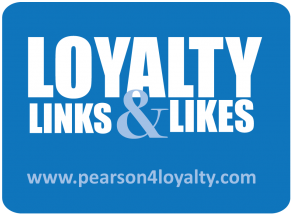Bryan Pearson's Blog, page 39
January 29, 2014
January 29: Loyalty Links & Likes
 Here are a few loyalty links that caught my eye this week.
Here are a few loyalty links that caught my eye this week.
1. Trend-Driven Resolutions for Retail Loyalty Marketers – Chief Marketer
Seven resolutions addressing some key issues in loyalty marketing for 2014.
2. Can Dunkin’ Donuts Rewards Compete with Starbucks? – CNBC
The coffee and donut chain has launched its new DD Perks rewards program nationally, how it measures up to competition.
3. When Dining, Please Leave Your Cell Phone On – COLLOQUY
What Starbucks, Jersey Mike’s and other QSRs have learned from using mobile payments.
4. The Revenge of the Customer in the Age of Fickle Loyalty – Venture Beat
A new study provides a snapshot of customer service in the United States and presents some telling figures in terms of loyalty.
5. In Search of TV Episodes: How Not to Reward Fan Loyalty – Huffington Post
Networks have made it difficult for viewers to find content they like and, in the process, they are missing out on opportunities to grow loyalty.
January 27, 2014
Seven Warning Signs that it is Time to Revamp Your Loyalty Program
 Starbucks was 40 years old and one of the most recognized brands in the world when it decided to revamp its logo in 2011. Yet the successful coffee chain knew that a number of factors, from a poor economy to more-focused competition, required it.
Starbucks was 40 years old and one of the most recognized brands in the world when it decided to revamp its logo in 2011. Yet the successful coffee chain knew that a number of factors, from a poor economy to more-focused competition, required it.
A less confident brand might not have pursued the change, but the bold move worked in Starbucks’ favor. The same goes for loyalty programs – regardless of one’s success and age, its operator needs to constantly watch out for events that can undermine its success.
A cost analysis is an obvious requirement, at least on a quarterly basis. But there are other less evident warning signs that will indicate when a company should revamp its loyalty program. Here are a seven of those signs:
A shift in participation activity: There are a variety of measures that reflect engagement, including collection frequency, scan rates and the percentage of sales tied to the loyalty program. These all should be monitored closely, and watch out for stealth trends that may be masking a broader problem. A shift in the age of primary shoppers, for example, may mean a decline in program use by your core, target market.
A high balance of unredeemed points: This is a sign that consumers are not recognizing the value of the program. The next step is defection to low-priced competitors. The program should offer more relevant or more immediate rewards.
The rivals look good: Just as airlines test proposed fare hikes by seeing if the competition will do the same, all organizations should match or beat what their rivals are doing. Every company has its defining benefit, either through the exclusive brands it offers or the experience or even its location. These qualities should always be used to edge out the competition.
The program has become a science: The risk of adding lots of levels of benefits and redemption options is complexity. If participation or redemption rates are down, it may be because the program is too hard to understand. The data can help companies stay on top of what their most valuable customers prefer, and deliver it in a straightforward fashion.
Negative WOM: Social media is great for many things, including temperature checks. If customers begin to negatively comment about the program via social media and question whether it is adding value to their lives, then desired benefits need to be added – fast. But be sure to analyze the nature of the complaints. The issue may simply involve timing or communication channels.
The program is a Luddite: To retain the interest of millennial consumers in particular, a single loyalty program should engage in multiple ways. If a program is not taking advantage of the new media channels available it will likely be overshadowed. That said, companies should not go into it willy-nilly. A lot of technologies, like mobile payments, are still in the early stages and may change dramatically in the next year.
The data isn’t teaching: If a program does not provide a sufficiently robust platform for data collection or for accessing consumers based on their shared insights, it is not doing what it was designed to do. Loyalty programs are vehicles for learning and sharing, for encouraging desired consumer behavior through elevated experiences – based on the data.
The Starbucks brand change was one reminder that even the strongest organizations need to occasionally wake up and smell the coffee. Consider these seven warning signs the alarms that will start the process.
January 22, 2014
January 22: Loyalty Links & Likes
 Here are a few loyalty links that caught my eye this week.
Here are a few loyalty links that caught my eye this week.
1. From CPG Wish to In-Store Sales Delivery: Connecting with Consumers and Shoppers to Create Loyalty – Business 2 Community
How loyalty programs can help CPGs compete with private label store brands.
2. For Loblaw, LoyaltyOne, Personalization Means Double-Digit Results – COLLOQUY
The fully digital PC Plus loyalty program has brought big results for the supermarket merchant, here’s how.
3. Creating Customer Loyalty, One Employee At a Time, Generates Competitive Advantage – The Gazette
It’s no secret that exceptional customer service can win loyalty; this story focuses on why companies should focus on their employees to build loyalty.
4. How Brands’ Virtual Currencies Encourage Customer Loyalty – The Guardian
Virtual currency such as Amazon Coins makes it easier and more affordable for customers to shop via certain channels. This story discusses its viability for the future.
5. 5 Lessons on Loyalty from Dearly Departed Chicago Businesses – Chicago Tribune
Some loyalty takeaways for businesses from companies that have closed their doors.
January 20, 2014
Binding Loyalty: A look at My Bookshelf
Ralph Waldo Emerson once wrote that our high respect for a well-read man (and I’ll add woman) is praise enough of literature. It also is evidence of the leadership value of some of the best books on my shelf.
Like many people, I rotate my bookshelf, lending out or donating some and replacing them with the latest titles. But there is a core library of books I maintain, for their enduring principles and lessons as much as for inspiration. As I set my sights on another year of fresh challenges, I want to share the best:
 How Will You Measure Your Life? Clayton Christensen
How Will You Measure Your Life? Clayton Christensen
Written following Christensen’s fight with cancer, “How Will You Measure Your Life?” takes on some of the most confounding and persistent struggles of today: how to find happiness in our careers and in our relationships. He then addresses them through the lessons of the world’s greatest companies, including Honda and Walmart.
With a disarmingly personal approach and straightforward language, Christensen gets to the heart of these challenges and provides thoughtful solutions rich in integrity. For example, he states, poignantly, that “for many of us, as the years go by, the dreams peel away,” but later resolves this by stating, “understanding what makes us tick is a critical step on the path to fulfillment.” I had the pleasure of watching Christensen present last fall at the World Business Forum in New York and he delivered then as he does in his book, with top-rate inspiration.
 Win With Advanced Business Analytics by Jean Paul Isson
Win With Advanced Business Analytics by Jean Paul Isson
It’s long been a frustration of mine that so many companies invest in collecting customer information but then have no idea how to use it toward engagement. This book is for all of those companies, and also for those that actually do know what to do with those insights.
Isson, the global vice president of business intelligence and predictive analytics at Monster Worldwide, has a highly sophisticated understanding of data analytics. Yet his instructions are written clearly, and not just for those with a PhD in the field. Marketers and even ad buyers can put down this book feeling markedly more confident and knowledgeable about the science of information analysis.
 The Future of Management by Gary Hamel
The Future of Management by Gary Hamel
Hamel, founder of the international management consulting firm Strategos, makes the case in this compelling read that the single most important quality to corporate success does not exist in operations, but in management innovation. Though not his most recent book (it published in 2007), this is a classic, containing the “refresher” principles we all should return to with regularity.
The book is structured in three parts. The first challenges the reader to envision and innovate his or her own management of the future. The second part presents case studies to see this visionary innovation in action. And in the third, the book presents instructional concepts for creating that future, in part by forcing us to answer the “how” as much as the “what.”
We all have our personal guidebooks that shepherd us through our daily and long-term goals. These represent a short list I am eager to expand, so feel free to share what is on your bookshelf. Happy reading.
January 15, 2014
January 15: Loyalty Links & Likes
 Here are a few loyalty links that caught my eye this week.
Here are a few loyalty links that caught my eye this week.
1. Caribou Coffee Debuts New Loyalty Program – Nation’s Restaurant News
The Minneapolis-based coffee chain has launched a rewards program that aims to surprise and delight.
2. Maintaining Interest: How a Surge in Bank Mergers May Spell Opportunity for Loyalty – COLLOQUY
More than half of small banks surveyed said they expect to be involved in a merger this year, where loyalty factors in to this trend.
3. Loyalty Programs Could Feel Target Data Breach Fallout – NBCNews.com
The story reveals the loyalty implications of the retailer’s security breach and what it could mean for other companies.
4. How to Create Mobile Apps Customers Will Actually Use – Loyalty360
Tips for companies looking to build loyalty through their mobile apps.
5. How Tim Theriault Helped Turn Walgreens from a Loyalty-Program Follower to a Leader – Chicago Tribune
A Q&A with the drugstore’s chief information officer about developing its new loyalty program.
January 14, 2014
Real-Time Offers Signal Opportunity, Not Loyalty
 Can a beacon of opportunity deliver a lifetime of loyalty? Not if it fails to make a connection beyond the pocket book.
Can a beacon of opportunity deliver a lifetime of loyalty? Not if it fails to make a connection beyond the pocket book.
This is what the buyers of technologies that deliver real-time offers should keep in mind. Many of these mobile-based innovations completely bypass loyalty programs, which may be of short-term convenience for consumers, but they have no long-term promise of generating a transcendent brand connection.
For instance, among such technologies I’ve recently come across is one that involves devices installed on retailers’ shelves, which interact with shoppers’ smartphones through a beacon. It sounds great – the shopper can download product information, coupons or other real-time offers and immediately redeem them.
However, this and other similar mobile-based technologies are limited in the amount of detailed insights they collect. Merchants that use these technologies but do not align them with a loyalty program miss out on gaining a more comprehensive understanding of the consumer. They also miss out on new ways to earn and redeem rewards.
Beacon devices and Bluetooth low energy are significant opportunities. The issue is a mobile connection means the merchant should have some insight into the consumer already, and this raises the question of how loyalty and customer information would enhance this value proposition. The answer can be found with failed technologies from the past, such as automated shopping carts, 3-D shopping, Palm Pilots, voice recognition and QR codes. They simply did not resonate.
The path to long-term viability, not just as a marketing tool but more importantly as something consumers really want to embrace over the long run, is the ability to make it relevant in the purest sense.
Real-time offers are evidently enticing for many reasons, but merchants should remember that as technology re-engineers traditional competition, the need for consumer understanding has never been greater. Once a more attractive or relevant technology emerges – or once every other merchant in town has the same technology – there will be little to distinguish one brand from the next.
But if the merchant has an accurate understanding of what its customers prefer and delivers on that, then its customers will continue to use the technology, because they are doing so for different reasons beyond convenience.
January 8, 2014
January 8: Loyalty Links & Likes
 Here are a few loyalty links that caught my eye this week.
Here are a few loyalty links that caught my eye this week.
1. American Airlines, US Airways Begin Integrating Benefit Programs – The Wall Street Journal
The merger, which created the world’s largest airline by traffic, will bring new benefits for customers including the ability to use their program across both carriers.
2. Calling TV’s Superfans: Nielsen Starts Tracking Networks’ Viewer Loyalty – AdAge
The ratings company is trying to standardize metrics to measure viewer loyalty and provide a link between sales.
3. Curious Coffee Drinker? This (Dis)loyalty Card is for You – Washington Post
Six D.C. coffee shops have banded together to offer a loyalty card for consumers that promises to provide the seventh brew for free regardless of where the others were purchased.
4. This Startup is Trying to Reinvent the Loyalty Program – Crain’s Chicago Business
A Chicago company hopes to compete with the likes of Belly and Groupon with its new program that uses a consumer’s existing credit cards.
5. Retail Loyalty Marketing: A Year in Review 2013 – COLLOQUY
A recap of some of the biggest loyalty stories in the retail industry from the past year.
January 6, 2014
News Flash: Media Company to Launch Loyalty Program, Edits Traditional Model
 One of America’s leading media companies is planning to test a loyalty program, but keeping that headline above the fold will require an initiative that stands above the fray.
One of America’s leading media companies is planning to test a loyalty program, but keeping that headline above the fold will require an initiative that stands above the fray.
The CEO of the E.W. Scripps Co., which operates 19 TV stations and 13 newspapers, revealed plans for the program in December. According to news stories, the loyalty plan follows the 2013 launch of a digital-only news service in Cincinnati, where Scripps is based. It’s a bit of a risk – the company has invested millions in the new digital model, and is making most of the content subscriber based. To keep its subscribers, it needs to be relevant.
Enter the loyalty program, which will be for subscribers in its Cincinnati test market, according to a story in the Cincinnati Business Courier.
In an email, a Scripps spokeswoman described the program as more like the Amazon model (“if you like this, you might like that”), through which it would use customer information such as story clicks and demographics to tailor its news content and ad messaging. So if you like to read political stories, for example, it may suggest reading a particular elections editorial.
Scripps is a good example of a non-traditional loyalty player looking to these types of tools as a break from its ordinary marketing and engagement devices, and it is not the first media group to do so. As outlined in a recent story by COLLOQUY, several publications, including the Chicago Tribune and the Virginia-Pilot, have tried and abandoned loyalty plans. Others are still trying.
All of which highlights the challenges of introducing a loyalty program that is effective. The trick is bringing relevance, through interactions that are as clearly advantageous to the consumer as the company. Consumer data is key to doing this.
This may be why Scripps CEO Richard Boehne hinted at finding other players well versed in customer data and loyalty – he mentions that Scripps is taking advantage of being based in Cincinnati, home of many consumer marketing leaders including Procter & Gamble, Macy’s and Kroger. “In Cincinnati, there is an awful lot of consumer marketing and data strength that we leverage by running this pilot in that program in that market,” he said.
This is good, because while loyalty programs are increasingly common, I’d bet only a small percentage of operators know how to use the data in a way that helps them understand and benefit their customers. For Scripps, the data could yield information that illustrates the readers’ news values, how and when they prefer to get their breaking headlines, and even the comics they like. This information can help Scripps determine messaging and what to offer as incentives to read articles.
I have a hunch that the Scripps announcement is the beginning of a trend, and we will see more industries exploring loyalty as a marketing tool. But like any good news story, the loyalty program will have to resonate with the reader if it wants the reader to stick with it.
December 30, 2013
Resolving to be a Better Loyalty Marketer

Art from Shutterstock.com
Many people begin their new year resolving to be better to others. If you are a loyalty marketer, a good way to be better to others is with pragmatism, partnerships and relevancy.
These are some of the qualities, along with sharing and moderation, that make up effective and beneficial loyalty marketing. So as the sun sets on this year, let us all try to rise to the occasion in the next. My four loyalty marketing resolutions for 2014:
1. Don’t be known as the “Loyalty Guy/Girl”: Let’s extend the effect of our loyalty assets by reaching out to two or three areas of our organizations that never thought of loyalty programs as a resource. Whether it’s using the customer information to view decision-making in a new way, or using the in-house currency as a means to change the way customers interact with our products, moving beyond the loyalty box will be critical to establishing a bigger role for customer loyalty and data within the business.
2. Beat back Big Data with pragmatism: There’s much talk about “big data” these days but maybe 2014 will herald a new approach to this event. We can change the conversation from “big” to “pragmatic” by instead focusing on how data can improve sales and profits in the next 12 months. A good first step – resolve to take three to five basic questions that the company struggles to answer and then apply the customer data to help the rest of the team address these challenges. It’s easy to get lost in too much data, so taking a targeted approach to solving the problems the company faces will raise the value of customer information and the program from which it arises.
3. Pick a new partner to extend your value proposition: In 2014, let’s try to develop one or two new partnerships based on what we know about our customers and what they value. We can often get wrapped up in our own value proposition and forget that we are sitting on a gold mine of customers who may be of interest to other brands. So how about dedicating part of 2014 by extending the brand experience to other companies? If we take the time to think about our customers, how they use our products or services and what could be done to enhance that application, then we will find where these complementary relationships exist. I am certain that great ideas, supported by real data and insights, will make it entirely possible to present an attractive proposition to those brands that add an interesting dimension to our own.
4. In 2014, have the data deliver relevance: This year, let’s resolve to make one or two critical efforts to use the information obtained from our customers to build a more relevant and transparent relationship. We can do this by assuring that customer not only understands that we collect this information, but also how it benefits them and adds value to the brand experience. We should consider what they buy from us, specifically, and then show value by recognizing their purchasing behavior in the offers we make to them through various marketing channels. This is not about how we present ourselves across all customers, but how we appear to the customer on a one-to-one basis.
Let’s all work to make the term loyalty marketer about something that’s much bigger than just a program. All the best for 2014!
December 23, 2013
From Dickens to Dickering: Winning Loyalty at a Bargain
 The week before Christmas has long been a sweet spot for bargain seekers, but these days they are taking the deal making into their own hands, and merchants are playing along.
The week before Christmas has long been a sweet spot for bargain seekers, but these days they are taking the deal making into their own hands, and merchants are playing along.
What I’d be interested in knowing, though, is the role their loyalty data plays.
A story in The New York Times documents several cases where merchants are willing to haggle over prices with their consumers. While this has long been somewhat commonplace among appliance and home electronics chains, the practice is extending to upscale merchants, including Bloomingdale’s and Nordstrom.
“Some retailers are training employees on the rules of bargaining,” the story states, citing Alison Kenny Paul, vice chairwoman of U.S. retail and distribution at Deloitte. “Instead of price discounts, those deals may be add-ons, like an extended warranty, free delivery or free installation.”
What has caused the season of Dickens to turn into a time of dickering?
Consumers are haggling because their smartphones are providing them more product information – including competitive pricing. Further, new online services, including DealScience and Greentoe.com, compare and rank online deals or invite consumers to submit their own offers on merchandise.
With that knowledge comes power. If consumers see that haggling works, they have no incentive to cut back. However, merchants can provide the incentive for consumers to come back – wrangling or not – through their loyalty data.
Loyalty program information is really the gift that keeps on giving, because every time the consumer returns, he or she provides more insights that can be used to curate the brand experience. This same data can help store employees identify best customers with whom haggling may be most beneficial.
That said, the data should not be taken for granted. The key to using it favorably at the bargaining table takes some segmenting to determine the best and most dedicated customers. Merchants should then make sure any preferential treatment starts with these most loyal customers, ensuring they are genuinely rewarded for their commitment to the brand.
After all, even a haggling session has the potential to be a positive brand experience. As consumers become more price savvy, this is what merchants should bargain for.
Bryan Pearson's Blog
- Bryan Pearson's profile
- 4 followers



